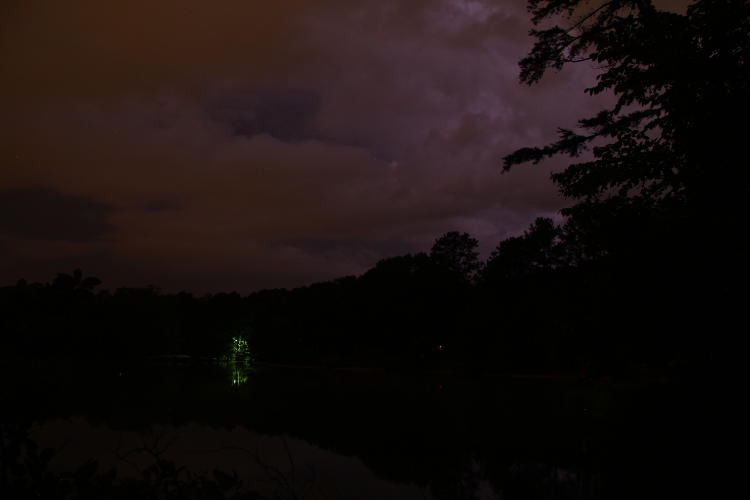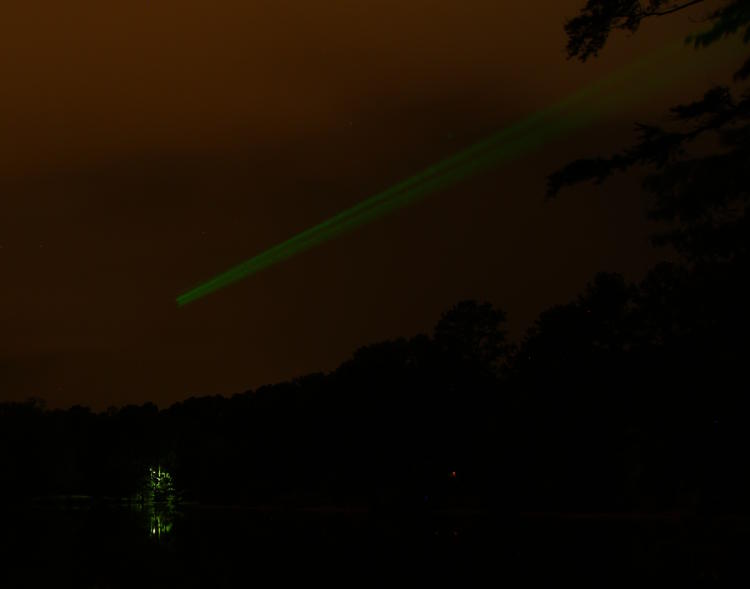This is just a trivial curiosity, found while sorting and set aside for a post when the season has slowed down. We’re not going into deep philosophical territory here.

Waaayyy back in July, during a failed attempt to get some lightning images, I tried a small experiment, and dug out the green laser pointer that I carry in my camera bag. I have this mostly for student outings, because it’s powerful enough to be seen during daylight and works a whole lot better than trying to describe where exactly a particular photo subject can be found within the foliage, but I’ve also used it for astronomical directions too. It’s one of those that you ardently avoid aiming towards any aircraft, but the risk of that was nil this evening. So while the shutter was open for a ten-second exposure, I aimed it roughly parallel to the lens axis and held it pointed off into the distance, as steady as I could.

Green lasers work so well for astronomy because they illuminate the atmospheric humidity better, and thus the line of the beam can be seen even when the pointer itself is shining on something, oh, a few thousand light-years off. I wanted to see how vivid it would show in the image, with a small sideline of how steady I could hold it. I expected a little better results on the former, and less on the latter; that beam really isn’t too wobbly for handheld at ten seconds. The origin, by the way, was from the right of the frame, so the wider beam there is both a matter of being a hell of a lot closer to the camera and of my hand moving laterally while aiming fairly well.
By itself, that’s just an idle curiosity, but there’s another detail that’s apparent that I find slightly more interesting: the beam has a very clear stopping point to it. I kind of expected it to fade off into darkness, which is what you would see when pointing out stars, but enough of the beam remains to serve as a guiding line. I didn’t expect it to stop, which tells me that it was actually hitting the undersides of the clouds. Now, knowing the storm conditions, they weren’t very far away, especially since they were obscuring lightning that wasn’t far off by itself, but I was also aimed pretty damn flat, which makes a lot greater distance to cover. My best guesstimate is that we’re talking in excess of a kilometer, minimum. It’s not hard to believe that the light could travel that far, but what we’ve got here is enough illumination of the atmospheric humidity to see it that entire distance, even capturing it in camera, which is much more impressive.
With some precise measurements at the time of the photo, especially with the beam being issued from two different known locations, someone much better at math than I could actually calculate the distance involved; I’m almost certain that too little can be derived from this particular image to do so. Still, I’m impressed, because that seems to be quite a range for the beam to remain visible. But there’s always the possibility that the shutter closed before the beam had gotten too far away…
Just for the sake of further trivia, that above statement remains possible, but to give an accurate idea, assuming that the beam was on the moment the shutter opened and the shutter was precisely ten seconds, a light beam could have gone to the moon and back better than three times – in ten seconds the beam would have traveled close to 3 million kilometers. Granted, its time within the atmosphere would have slowed the photons slightly, but that would only have been for a fraction of a second. I did not calculate the effects of local dark matter, however…



















































